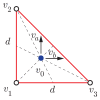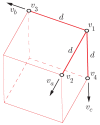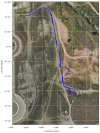A Redundant Configuration of Four Low-Cost GNSS-RTK Receivers for Reliable Estimation of Vehicular Position and Posture
- PMID: 34502744
- PMCID: PMC8434592
- DOI: 10.3390/s21175853
A Redundant Configuration of Four Low-Cost GNSS-RTK Receivers for Reliable Estimation of Vehicular Position and Posture
Abstract
This paper proposes a low-cost sensor system composed of four GNSS-RTK receivers to obtain accurate position and posture estimations for a vehicle in real-time. The four antennas of the receivers are placed so that every three-antennas combination is optimal to get the most precise 3D coordinates with respect to a global reference system. The redundancy provided by the fourth receiver allows to improve estimations even more and to maintain accuracy when one of the receivers fails. A mini computer with the Robotic Operating System is responsible for merging all the available measurements reliably. Successful experiments have been carried out with a ground rover on irregular terrain. Angular estimates similar to those of a high-performance IMU have been achieved in dynamic tests.
Keywords: GNSS receivers; RTK corrections; sensor redundancy; vehicle localization.
Conflict of interest statement
The authors declare no conflict of interest.
Figures













References
-
- Ahmad N., Ariffin R., Ghazilla R., Khairi N.M., Kasi V. Reviews on various Inertial Measurement Unit (IMU) sensor applications. Int. J. Signal Proc. Syst. 2013;1:256–262. doi: 10.12720/ijsps.1.2.256-262. - DOI
MeSH terms
Grants and funding
LinkOut - more resources
Full Text Sources

